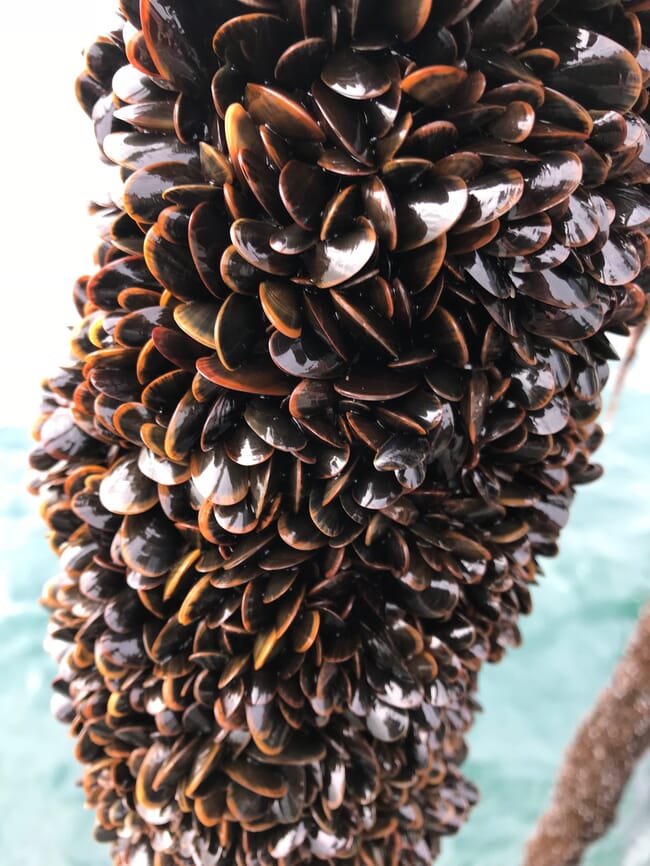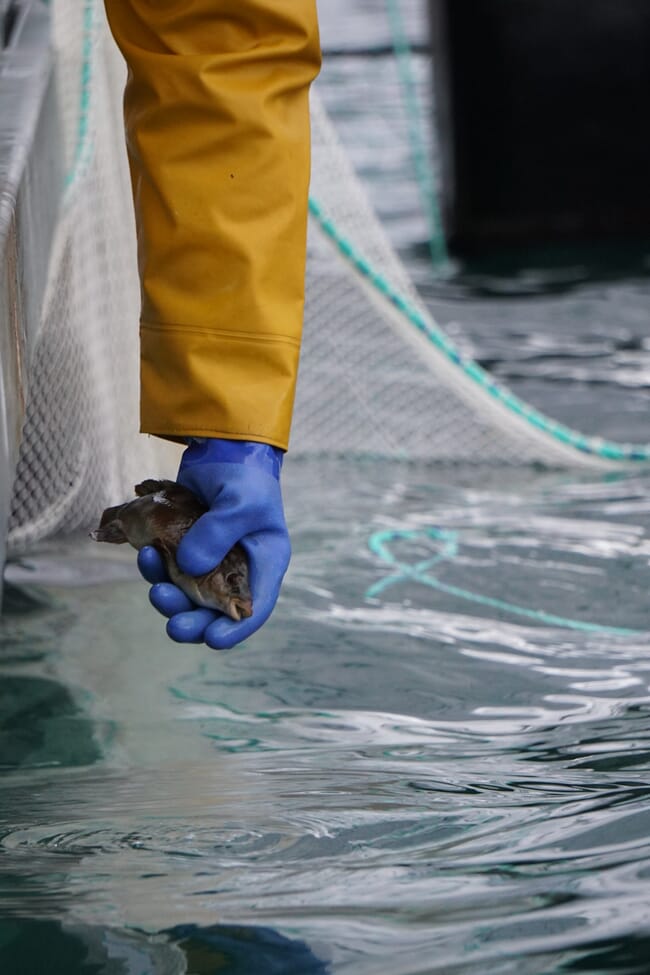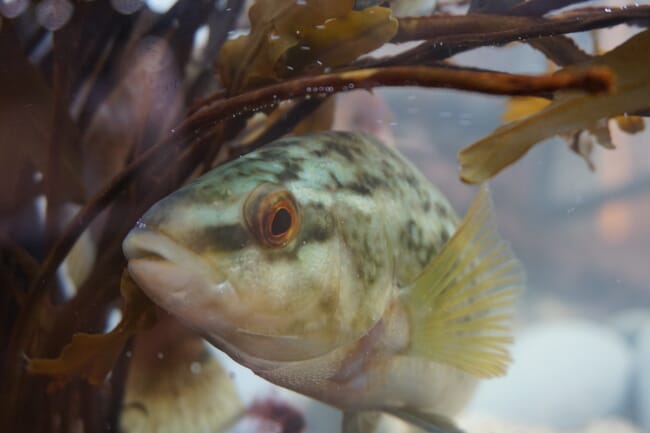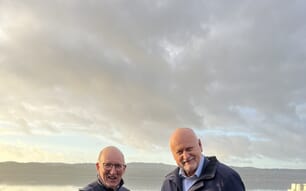When pioneering mussel farming company Offshore Shellfish Ltd (OSL) sent a lorry load of very large mussels to Denmark for processing into IQF meats, they had human consumption in mind for the product. Then a chance call from Gilpin Bradley, MD of Wester Ross Salmon, opened up another interesting possibility.

© Offshore Shellfish
Bradley was seeking a regular supply of mussels to feed to his wrasse, which are used to keep sea lice numbers down in the Wester Ross salmon pens. The first consignment went down well with the wrasse, and Bradley placed a regular order.
“Our wrasse are fished from the wild, so it is really important that we look after their health and welfare, so that we can make best use of them and help their longevity. We have found them to be discerning in their taste, with a fondness for mussels, which is not surprising, as molluscs and crustaceans are an important part of their diet in the wild,” Bradley told The Fish Site.
“We use a ratio of around one wrasse to 50 salmon, and since we started to pay more attention to their diet, have found them to be far more efficient workers,” he added.
OSL managing director John Holmyard explained that over the past couple of years he has experimented with different configurations of equipment and stocking densities on the mussel lines, while learning how the dynamics of the offshore farm operate.

© Offshore Shellfish
“We ended up with a number of ropes of very large mussels that were too big for any of our customers, so thought we would look at alternative uses for them. An IQF core product seemed the most sensible starting point for lots of different products,” said Holmyard.
“We were surprised when Wester Ross got in touch, but are delighted that our mussels are keeping their wrasse healthy and happy,” he added.
Cleaner fish such as ballan wrasse (Labrus bergylta) and lumpsuckers have become an integral part of the farmed salmon industry, since their tentative introduction a decade or so ago. By eating the sea lice that live on farmed fish, they prevent unnecessary chemicals from entering the environment, and save fish farmers money.
Lice-eating species are now caught and farmed on a large scale for use as an effective form of biological delouser. They are widely considered to be a key element of integrated pest-management control and have been partially credited with the average number of sea lice on Scottish farms reaching their lowest level since 2013.
Several hatcheries have been set up in Norway and the UK, including those operated by Otter Ferry, Dorset Cleanerfish Ltd, Ocean Matters and Mowi. At present, wrasse present more of a challenge to them than lumpfish, although rapid progress is being made. The hatcheries come nowhere near to meeting the needs of the growing salmon farming industry, but it is important for future sustainability that the current dependence on wild-caught cleaner fish is reduced.
Diet makes the difference
In the early days, it was assumed that cleaner fish needed little in the way of attention or maintenance feed, that they would happily coexist with salmon and that sea lice alone would provide for their nutritional needs. However, high mortality rates and poor results soon showed that a rethink was needed.
Enter the scientists, who found that insufficient access to the correct nutrients compromised the health of the cleaner fish, leading to emaciation and sickness, and a reduced ability to function efficiently.
Their results gave feed companies the confidence to start researching and developing species-specific cleaner-fish feed, which is credited with increasing the general welfare, robustness and longevity of caged cleaner fish, and increasing their delousing capacity.
BioMar’s Symbio concept, for example, includes ingredients such as krill meal, to meet different species’ taste requirements. Its Symbio product group covers the feeding needs of lumpfish and wrasse from the larval stage, through starter feed, to grower and health feeds, ensuring that their nutritional feeds are catered for during onshore production and as lice-eaters in the sea.
Welfare is key
Cleaner fish are covered by animal-welfare legislation and their use and feeding is included in the RSPCA Welfare Standards for Farmed Atlantic Salmon, the Code of Good Practice for Scottish Finfish Aquaculture (CoGP) and the Soil Association Organic Standards. However, none of the standards are as detailed as those of the Norwegian Seafood Research Fund (FHF), which are species-specific, and cover the whole life-cycle of lumpsuckers and ballan wrasse (the FHF best-practice guidelines in English can be downloaded here).
Scottish Sea Farms adheres to the RSPCA standards on the use and care of cleaner fish, but head of fish health Ralph Bickerdike told The Fish Site that his company has also produced a complementary document for internal use, which brings together best practice for the use of wrasse and lumpfish.
“We pay careful attention to the selection, transportation and delivery of our cleaner fish and ensure they are given specialist feed with their own feeding regimes. Husbandry is also a high priority, including the provision of specialist hides, routine welfare and health checks,” said Bickerdike.
Species-specific places to hide and rest are essential in order for cleaner fish to thrive, and many farmers provide artificial kelp forests that mimic the rocky shore environment in which wrasse are naturally found. A similar arrangement is provided for lumpfish, which need to stick to a surface to rest.
Salmon consciously seek out the hiding places of cleaner fish, and researchers have found that it is important for the workers to feel at home in their environment, as this is where much of the biological delousing takes place.
The majority of wrasse are still captured from the wild and transported to the farms, which presents something of a biosecurity risk. Farmed cleaner fish have the advantage that biosafety issues can be dealt with in a contained hatchery environment.

© Barbora Gaborova
Research breakthroughs
Scottish Sea Farms has just come to the end of a four-year applied research project with Mowi, the University of Stirling, BioMar and the Scottish Aquaculture Innovation Centre (SAIC), which looked at the implications of scaling up the use of cleaner fish and enhancing their welfare within hatcheries and out at sea. In particular, it aimed to develop an aquaculture system for ballan wrasse that would provide a sustainable stock.
The project team bred wild-caught wrasse, raised the offspring to adults of reproductive age, and successfully bred from this generation, completing the first fully farmed life-cycle of wrasse in a controlled environment. A further milestone was achieved by weaning the wrasse larvae and fry from live food to a dry diet.
It is hoped that their success will move the salmon sector a step further towards its ambition of becoming self-sustaining in the use of farmed stocks of cleaner fish, and to control sea lice through sustainable, non-medicinal, environmentally friendly approaches.
“The project provided a proven, repeatable procedure for breeding, weaning and rearing wrasse that will lead to a reduced reliance on wild stock,” said Mowi Scotland’s hatchery manager, Paul Featherstone.
Lessons learned about husbandry, feeding and welfare, along with an insight into the latest international research, was shared at a recent sector-wide workshop on cleaner fish, organised by the Scottish Salmon Producers Organisation (SSPO).

© Barbora Gabarova
Delegates heard that the next step for wrasse culture is to improve the quality of the eggs, which will help hatcheries to upscale production and to produce more robust stock. The sector also needs more hatcheries and people trained to operate them, if industry needs are to be met in the future.
In Norway, around £5.9 million is being invested this year by FHF in R&D initiatives to prevent and control sea lice. A high priority is being given to the quality, welfare and feeding of cleaner fish, as well as to achieving reductions in loss and mortality and the development of better methods for their effective capture, responsible stunning, slaughter and sustainable post-use.
“No theme is more important to the aquaculture industry than the struggle to prevent and control salmon lice, and R&D efforts are absolutely crucial. For several years, FHF has had salmon lice as the highest priority single area and 2019 is no exception,” said Kjell Maroni, R&D aquaculture director for the Norwegian Seafood Research Fund.




